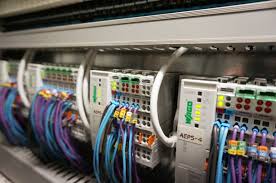During the second week in Sodenborg, we worked with PLC.
What is PLC?
A Programmable Logic Controller (PLC) is a computer controller used for controlling and automating industrial processes. PLC programming is the process of creating program code for the controller, which is used to control the process in real-time.
PLC programming begins with collecting requirements for controlling the process. Then a control plan is developed, which includes a series of inputs and outputs and logical operations used for controlling the process.
Program code is then written in programming languages such as Ladder Logic, Function Block Diagram (FBD), Structured Text (ST), and many others. Ladder Logic is the most commonly used programming language in PLC programming as it is easy to understand and use.
After writing the code, the program is transferred to the controller and executed. The PLC then monitors input signals and executes the control plan. If the process state changes, the control plan changes and executes new commands for controlling the process.
PLCs are an important element in automating industrial processes, as they provide reliable and precise process control in real-time. PLC programming can be used in various industries such as manufacturing, construction, energy, and more.
However, PLC programming can prove to be a complex process, so it is recommended to be carried out by a skilled and experienced PLC programmer who has knowledge of industrial processes and programming languages used in PLC programming






